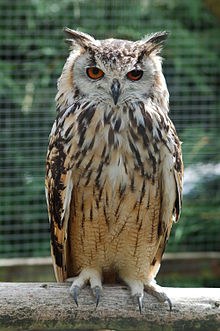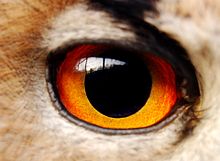Horned owl
| Horned owls and eagle-owls Temporal range: Late Pliocene to present
| |
|---|---|

| |
| Indian eagle-owl (Bubo bengalensis) | |
| Scientific classification | |
| Domain: | Eukaryota |
| Kingdom: | Animalia |
| Phylum: | Chordata |
| Class: | Aves |
| Order: | Strigiformes |
| Family: | Strigidae |
| Genus: | Bubo Duméril, 1805 |
| Type species | |
| Strix bubo Linnaeus, 1758
| |
| Species | |
|
See text | |
| Synonyms | |
The American (North and South America) horned owls and the Old World eagle-owls make up the genus Bubo, at least as traditionally described. The genus name Bubo is Latin for owl. Its name in Russian филин (Russian for 'filin') is one of the few native Russian words containing the letter Ф.
This genus contains 10 species that are found in many parts of the world. Some of the largest living Strigiformes are in Bubo. Traditionally, only owls with ear-tufts were included in this genus, but that is no longer the case.

Taxonomy
[edit]
The genus Bubo was introduced in 1805 by the French zoologist André Duméril for the horned owls.[2] The type species is the Eurasian eagle-owl.[3] The word bubo is Latin for the Eurasian eagle owl and was used as the specific epithet for the species by Carl Linnaeus in 1758.[4]
A molecular phylogenetic study published in 2020 found that species in the genera Scotopelia and Ketupa were embedded within the clade containing members of the genus Bubo making the genus Bubo paraphyletic. To create monophyletic genera, nine species were moved from Bubo to Ketupa.[5][6]
Species
[edit]The genus contains 10 extant species:[6]
- Snowy owl, Bubo scandiacus
- Great horned owl, Bubo virginianus
- Lesser horned owl, Bubo magellanicus
- Eurasian eagle-owl, Bubo bubo
- Indian eagle-owl, Bubo bengalensis
- Pharaoh eagle-owl, Bubo ascalaphus
- Cape eagle-owl, Bubo capensis
- Arabian eagle-owl, Bubo milesi
- Greyish eagle-owl, Bubo cinerascens
- Spotted eagle-owl, Bubo africanus

Sometimes included in this genus:
- Verreaux's eagle-owl, Ketupa lactea
- Spot-bellied eagle-owl, Ketupa nipalensis
- Barred eagle-owl,Ketupa sumatrana
- Fraser's eagle-owl,Ketupa poensis
- Akun eagle-owl, Ketupa leucosticta
- Philippine eagle-owl, Ketupa philippensis
- Dusky eagle-owl, Ketupa coromanda
- Shelley's eagle-owl, Ketupa shelleyi
- Blakiston's fish owl, Ketupa blakistoni
- Brown fish owl, Ketupa zeylonensis
- Tawny fish owl, Ketupa flavipes
- Buffy fish owl, Ketupa ketupu
- Pel's fishing owl, Scotopelia peli
- Rufous fishing owl, Scotopelia ussheri
- Vermiculated fishing owl, Scotopelia bouvieri
Fossil record
[edit]Named and distinct Bubo species are:
- Bubo florianae (Late Miocene[verification needed] of Csákvár, Hungary, tentatively placed here)
- Bubo leakeyae (Early Pleistocene of Tanzania)
- Bubo binagadensis (Late Pleistocene of Binagady, Azerbaijan)
- Bubo osvaldoi (Pleistocene of Cuba)[7]
- Bubo insularis (Pleistocene of Sardinia)
Some notable undescribed fossils of prehistoric horned owls, usually quite fragmentary remains, have also been recorded:
- Bubo sp. (Late Pliocene of Senèze, France)[8]
- Bubo sp. (Late Pliocene of Rębielice Królewskie, Poland; tentatively placed here)[9]
- Bubo sp. (Late Pleistocene of San Josecito Cavern, Mexico)[10]
Specimen UMMP V31030, a Late Pliocene coracoid from the Rexroad Formation of Kansas (U.S.), cannot be conclusively assigned to either Bubo or Strix. This fossil is from a taxon similar in size to the great horned owl (B. virginianus) or the great grey owl (S. nebulosa).[11]
The Sinclair owl (Bubo sinclairi) from Late Pleistocene California may have been a paleosubspecies of the great horned owl,[12] while the roughly contemporary Bubo insularis of the central and eastern Mediterranean has been considered a junior synonym of a brown fish owl paleosubspecies.[13] Additional paleosubspecies are discussed on the appropriate species page.
Several presumed Bubo fossils have turned out to be from different birds. The Late Eocene/Early Oligocene eared owls "Bubo" incertus and "Bubo" arvernensis are now placed in the fossil barn owl genera Nocturnavis and Necrobyas, respectively. "Bubo" leptosteus is now recognized as primitive owl in the genus Minerva (formerly Protostrix). "Bubo" poirreiri from the Late Oligocene or Early Miocene of Saint-Gérard-le-Puy in France, is now placed in Mioglaux.
On the other hand, the supposed fossil heron "Ardea" lignitum from the Late Pliocene of Plaue-Rippersroda (Germany) was apparently an owl and close to Bubo or more probably actually belongs here. Given its age – about 2 million years ago or so – it is usually included in the Eurasian eagle-owl today.[14]
Interactions with humans
[edit]Because of their nocturnal habits, most owls do not directly interact with humans. However, in 2015, an eagle owl in Purmerend, Netherlands, attacked some 50 people before it was caught by a hired falconer.[15]
Footnotes
[edit]- ^ Possibly a junior synonym of Ketupa, if that is a valid genus: Pavia (1999), Mlíkovský (2002, 2003).
- ^ Duméril, A. M. Constant (1805). Zoologie analytique : ou, Méthode naturelle de classification des animaux; endue plus facile a l'aide de tableaux synoptiques (in French). Paris: Allais. p. 34. The book bears the date of 1806 on the title page but was actually published in 1805. See: Gregory, Steven M.S. (2010). "The two 'editions' of Duméril's Zoologie analytique, and the potential confusion caused by Froriep's translation Analytische Zoologie" (PDF). Zoological Bibliography. 1 (1): 6–8.
- ^ Peters, James Lee, ed. (1940). Check-List of Birds of the World. Vol. 4. Cambridge, Massachusetts: Harvard University Press. p. 110.
- ^ Jobling, James A. (2010). The Helm Dictionary of Scientific Bird Names. London: Christopher Helm. p. 179. ISBN 978-1-4081-2501-4.
- ^ Salter, J.F.; Oliveros, C.H.; Hosner, P.A.; Manthey, J.D.; Robbins, M.B.; Moyle, R.G.; Brumfield, R.T.; Faircloth, B.C. (2020). "Extensive paraphyly in the typical owl family (Strigidae)". The Auk. 137 (ukz070). doi:10.1093/auk/ukz070. hdl:2346/93048.
- ^ a b Gill, Frank; Donsker, David; Rasmussen, Pamela, eds. (January 2023). "Owls". IOC World Bird List Version 13.1. International Ornithologists' Union. Retrieved 31 January 2022.
- ^ Arredondo, O; Olson, SL. "A New Species of Owl of the Genus Bubo from the Pleistocene of Cuba (Aves: Strigiformes)" (PDF). Proc. Biol. Soc. Wash. 107 (3): 436–444. Retrieved 2 December 2012.[permanent dead link]
- ^ Lambrecht (1933): p. 616
- ^ Mlíkovský (2002)
- ^ A single bone of a large horned owl distinct from B. virginianus: Steadman et al. (1994)
- ^ Feduccia (1970)
- ^ Howard (1947)
- ^ Mlíkovský (2002, 2003)
- ^ Olson (1985): p. 167, Mlíkovský (2002)
- ^ ""Horror owl" caught in Purmerend; had attacked 50 people". NL Times. 13 March 2015. Retrieved 6 July 2021.
References
[edit]- Feduccia, J. Alan; Ford, Norman L. (1970). "Some birds of prey from the Upper Pliocene of Kansas" (PDF). Auk. 87 (4): 795–797. doi:10.2307/4083714. JSTOR 4083714.
- Howard, Hildegarde (1947). "A preliminary survey of trends in avian evolution from Pleistocene to recent time" (PDF). Condor. 49 (1): 10–13. doi:10.2307/1364422. JSTOR 1364422.
- König, Claus; Weick, Friedhelm & Becking, Jan-Hendrik (1999): Owls: A guide to the owls of the world. Yale University Press, New Haven. ISBN 978-0-300-07920-3
- Lambrecht, Kálmán (1933): Handbuch der Palaeornithologie [Handbook of Paleornithology]. Gebrüder Bornträger, Berlin. [in German]
- Mlíkovský, Jiří (2002): Cenozoic Birds of the World, Part 1: Europe. Ninox Press, Prague.
- Mlíkovský, Jiří (2003). "Brown Fish Owl (Bubo zeylonensis) in Europe: past distribution and taxonomic status" (PDF). Buteo. 13: 61–65. Archived from the original (PDF) on 2007-09-27. Retrieved 2008-09-19.
- Olsen, Jery; Wink, Michael; Sauer-Gürth, Heidi; Trost, Susan (2002). "A new Ninox owl from Sumba, Indonesia" (PDF). Emu. 102 (3): 223–231. Bibcode:2002EmuAO.102..223O. doi:10.1071/MU02006. S2CID 86526031. Archived from the original (PDF) on 2009-09-30. Retrieved 2006-12-23.
- Olson, Storrs L. (1985): The fossil record of birds. In: Farner, D.S.; King, J.R. & Parkes, Kenneth C. (eds.): Avian Biology 8: 79–238. Academic Press, New York.
- Pavia, Marco (1999). "Un cranio di Bubo insularis Mourer-Chauviré & Weesie, 1986 (Aves, Strigidae) nelle brecce ossifere del Pleistocene di Capo Figari (Sardegna, Italia)" [A cranium of B. insularis from the Pleistocene ossiferous breccia of Cape Figari (Sardinia, Italy)] (PDF). Atti della Accademia delle Scienze di Torino, Classe di Scienze Fisiche, Matematiche e Naturali (in Italian and English). 133: 1–10. Archived from the original (PDF) on 2012-09-25. Retrieved 2009-06-23.
- Steadman, David William; Arroyo-Cabrales, Joaquin; Johnson, Eileen; Guzman, A. Fabiola (1994). "New Information on the Late Pleistocene Birds from San Josecito Cave, Nuevo León, Mexico" (PDF). Condor. 96 (3): 577–589. doi:10.2307/1369460. JSTOR 1369460.
External links
[edit] Media related to Bubo at Wikimedia Commons
Media related to Bubo at Wikimedia Commons

